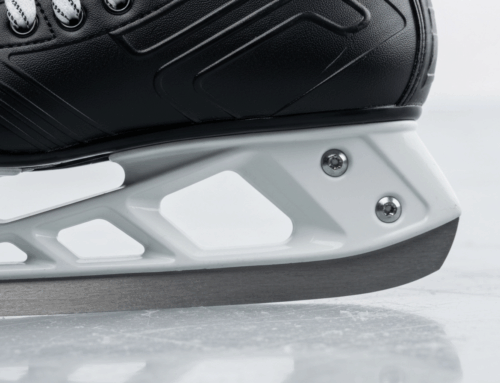Essential High-tech hockey laceration protection for Skaters
Understanding the Silent Threat in Ice Hockey
Ice hockey, a sport renowned for its speed, intensity, and physical contact, inherently carries a risk of injury. While concussions, sprains, and fractures often dominate discussions around player safety, a less frequently highlighted but potentially catastrophic injury is the skate blade laceration. These incidents, though statistically rare, can result in severe trauma due making High-tech hockey laceration protection a critical area of focus. The unique dynamics of the game, with sharp blades moving at high velocities in close proximity, create an environment where a sudden fall or collision can lead to life-altering cuts.
Tragic Lessons Learned from High-Profile Incidents
The hockey world has been profoundly impacted by several high-profile skate blade lacerations, tragically underscoring the urgent need for enhanced player safety. The passing of former NHL player Adam Johnson in October 2023, due to a skate blade injury to the neck during a game, sent shockwaves globally. This devastating event brought renewed attention to incidents that have occurred previously, such as the widely publicized neck lacerations suffered by NHL players Clint Malarchuk in 1989 and Richard Zednik in 2008. Both Malarchuk and Zednik underwent emergency medical intervention and made remarkable recoveries, a testament to rapid medical response. More recently, in 2022, a high school player also succumbed to a skate laceration, and NHL player Evander Kane sustained a serious wrist laceration. These incidents, alongside others involving various body parts, highlight that while rare, skate blade injuries demand proactive prevention and robust protective measures, especially with the rise of High-tech hockey laceration protection innovations.
The Elusive Data on Skate Blade Injuries
Accurately quantifying the incidence of skate blade lacerations in ice hockey presents a significant challenge. A primary reason for this data gap is the common practice of on-site laceration repair by team medical staff, particularly at professional and elite amateur levels. This often leads to under-reporting in official medical databases that would otherwise meticulously track such injuries. Furthermore, differentiating skate blade lacerations from other types of cuts caused by pucks, sticks, or impacts with the ice or boards adds another layer of complexity to data collection. Despite these challenges, an important 2009 study involving over 11,000 USA Hockey players provided some insights, indicating that neck lacerations from skate blades were infrequent, with most requiring only basic bandaging. However, the severity of these injuries, when they do occur, underscores the need for more comprehensive injury tracking. Better epidemiological data would be invaluable for developing and refining targeted prevention strategies, enhancing player safety protocols, and advancing rehabilitation techniques.
Advancements in High-tech Hockey Laceration Protection Gear
The pursuit of effective prevention strategies for skate laceration injuries in hockey is a multi-faceted endeavor that heavily relies on advanced protective equipment. The cornerstone of this prevention lies in the use of materials engineered to resist sharp blades. Significant strides in protective technology have led to the development of specialized cut-resistant clothing, including socks, shirts, and wrist sleeves. These garments often incorporate synthetic fibers known for their exceptional strength, such as those found in bulletproof vests. Padded and cut-resistant neck guards are another crucial component, designed specifically to mitigate the risk of severe lacerations to the neck and throat area.
Research into the effectiveness of these materials continues to evolve. For instance, a 2015 study examining commercially available neck guards identified that the most effective products often featured unique designs, such as multiple layers of advanced protective fibers or the integration of materials like Spectra Guard, which boasts superior tensile strength and elasticity compared to other traditional options. Many hockey gear manufacturers are now publicly committing to producing more protective equipment, particularly neck guards, reflecting an industry-wide push for enhanced safety. To understand the foundational materials contributing to these advancements, you can explore the evolution of material technology in hockey gear. Furthermore, gaining insight into the broader evolution of cut-resistant technology provides a comprehensive view of how these innovations have developed over time. In a significant move, USA Hockey mandated the use of neck laceration protection for all players and officials under 18 starting August 1, 2024, for both games and practices. While adult professional leagues in the US have not yet uniformly adopted such mandates, many Canadian leagues and Hockey Canada’s women’s division already require cut-resistant neck guards.
Beyond Equipment: Rule Changes and Emergency Preparedness
Beyond the critical role of High-tech hockey laceration protection equipment, in-game rule adjustments and stringent emergency preparedness protocols are vital for improving player safety. Junior leagues have implemented stricter regulations to minimize dangerous play, such as penalties for specific types of body-checking and high-sticking, aimed at reducing high-impact collisions and reckless maneuvers that could lead to blade-related incidents. Enforcement of multi-game suspensions for egregious contact further reinforces player accountability for safety on the ice.
Even with advanced equipment and evolving rules, skate blade injuries remain a possibility, making a comprehensive emergency action plan indispensable for effective injury management. Professional leagues like the NHL maintain robust emergency protocols, including a minimum of three on-site physicians (orthopedist, primary care, emergency medicine), two ambulances, and automated external defibrillators (AEDs) at every game. Team physicians are required to be proficient in hockey-specific trauma management, and regular simulated drills, including those for catastrophic skate lacerations, ensure medical staff are well-prepared for rapid response. The introduction of neck vascular laceration simulation models allows medical teams to practice managing severe carotid or jugular lacerations, emphasizing the importance of immediate care and rapid transfer to a trauma hospital to mitigate morbidity and mortality.
Critical Care: Managing Severe Skate Lacerations
Despite all preventative measures, skate blade lacerations can still occur. Studies have shown that even with cut-resistant neck guards, a portion of surveyed hockey players still sustained neck lacerations, often due to an unprotected area between the guard and helmet. The management of these injuries varies significantly based on their depth, location, and potential for severe anatomical damage. While most skate blade lacerations are superficial, non-life-threatening, or non-limb-threatening, severe cases demand immediate and precise intervention.
For minor lacerations, the management typically involves:
- Wound irrigation
- Assessment for deeper tissue injury (neurovascular, musculotendinous)
- Primary laceration repair (suture, skin glue, or bandages)
- Surgical repair if deeper tissues are involved
- Tetanus vaccination update
In cases of limb-threatening arterial or venous lacerations, such as to the femoral or brachial artery, immediate action is critical:
- Application of a tourniquet
- Use of hemostatic gauze if available
- Immediate EMS transfer to a hospital
- Emergent vascular repair
Life-threatening lacerations, particularly to major vessels like the common or internal carotid artery or internal/external jugular vein, necessitate an even more urgent response:
| Type of Life-Threatening Laceration | Immediate Management |
|---|---|
| Common or Internal Carotid Artery | One-finger occlusion of laceration (avoid complete compression to prevent ischemic stroke); immediate EMS transfer to hospital; maintain laceration occlusion during transport; emergent vascular repair. |
| Internal or External Jugular Vein | Pack the wound to tamponade slower bleeding; use hemostatic gauze if available; immediate EMS transfer to hospital; maintain pressure during transport; emergent vascular repair. |
| Airway Laceration | Secure airway if able; immediate EMS transfer to hospital; emergent surgical exploration and repair. |
Given the rapid blood loss potential (e.g., a common carotid artery can lead to significant hemorrhage within minutes), swift initiation of fluid resuscitation and transfusion protocols, coupled with rapid transfer to a trauma hospital, is paramount for survival.
Forging a Safer Path for Hockey Players
The exact incidence of skate blade lacerations in ice hockey remains challenging to establish due to reporting complexities, yet their potential for devastating outcomes cannot be overstated. Safeguarding players against these unique injuries requires a concerted effort focused on prevention. This includes the consistent enforcement of rules designed to minimize high-risk plays and a widespread adoption of cut-resistant gear. While many youth and international leagues have stepped forward by mandating High-tech hockey laceration protection, particularly for the neck, major professional leagues in the US still have an opportunity to lead in this regard.
Encouraging the use of advanced cut-resistant equipment not only for the neck but also for other vulnerable areas like the wrists and ankles, is essential for reducing injury risk. In the unfortunate event that a skate laceration compromises a major artery or the airway, the presence of on-site emergency medical services (EMS) and swift transfer to a trauma hospital can be the decisive factor between life and death. Continuous medical staff preparedness, facilitated by comprehensive emergency action plans, realistic on-ice simulations, and collaborative pre-game briefings with all medical teams, is crucial for ensuring a familiar and effective response when an emergency strikes, ultimately forging a safer path for every player who steps onto the ice.
Have questions? Contact us here.

We use only the finest ingredients to produce stellar tastes.












